Design
Digital Experiences
Thought Leadership
The Stories in These Walls
Published in The Society for College and University Planning Newsletter
Written by
John Roberson, Advent
Toby Marlatt, University of Wyoming Foundation
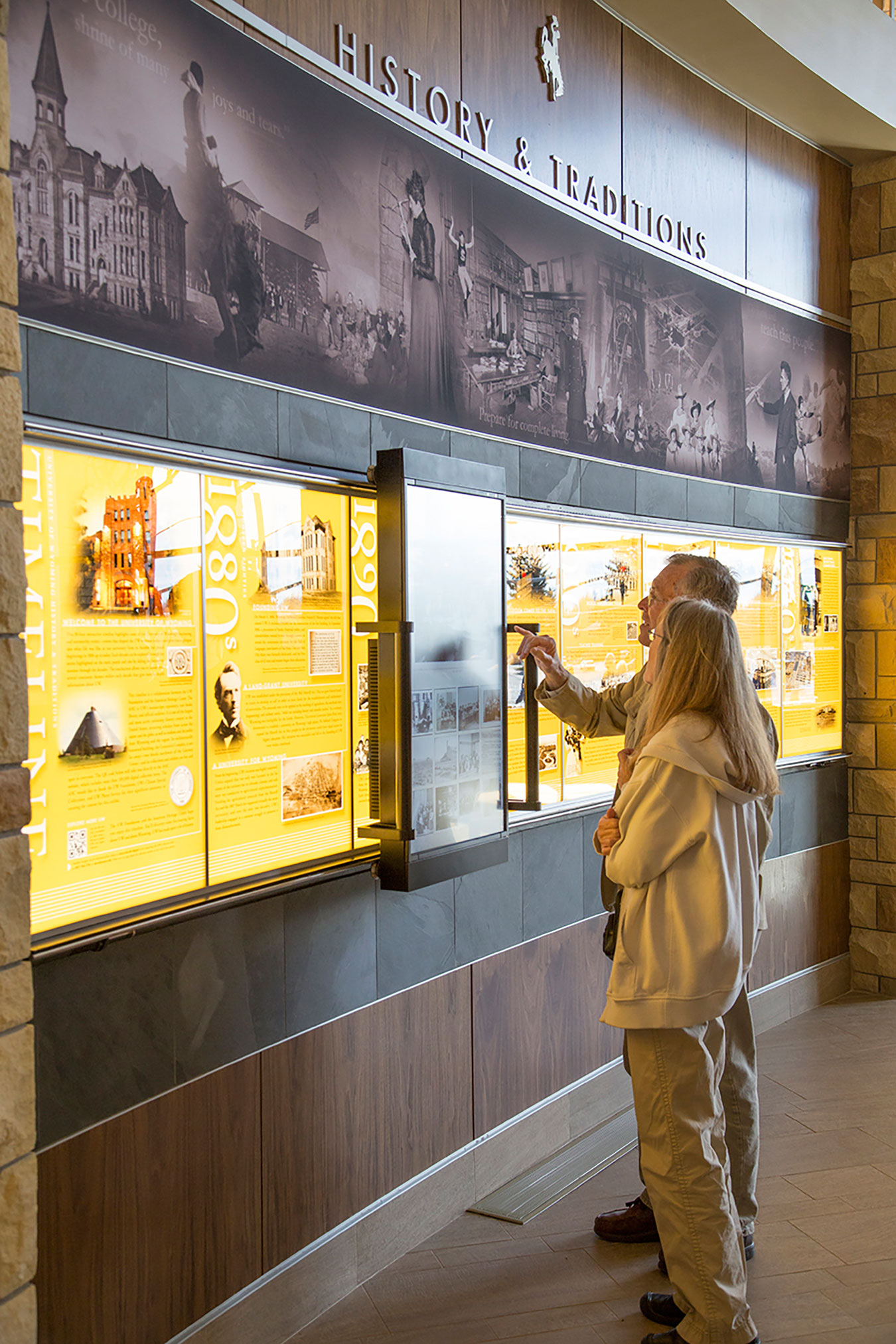
Integrated Planning Throughout Capital Projects Can Fuel Donor Engagement and Enhance Stewardship
When the University of Wyoming Foundation approached donors to invest in the Marian H. Rochelle Gateway Center at the University of Wyoming (UW), the foundation’s leadership brought more than photorealistic renderings and statistics about square footage or meeting rooms.
They also brought a story.
The University of Wyoming Foundation planned for the Rochelle Gateway Center to be the premier entry point for the university, a place for prospective students and families to begin their exploration of UW, and a location for alumni and friends to gather when they return to campus. The visionary $35-million project was to be funded entirely with private support, so meaningful donor engagement would be the key to its success.
Through collaboration between the University of Wyoming Foundation, the university administration, the architect, and outside consultants, the foundation deployed a distinctive plan for its proposals to donors. Every stakeholder played a key role in the storytelling. The foundation team positioned donors as protagonists. The result was a successful project that raised most of the funds in four months, including the lead gift of $10 million from the building’s namesake, Marian H. Rochelle, and a significant gift of $6 million from the McMurry Foundation.
Engaging donors at the planning stage is a critical step in the success of a capital project. Before a development officer slides a proposal across a table to a donor, collaboration early in the process among capital project teams within the university—and in some cases, outside consultants—can elevate and differentiate the ask.
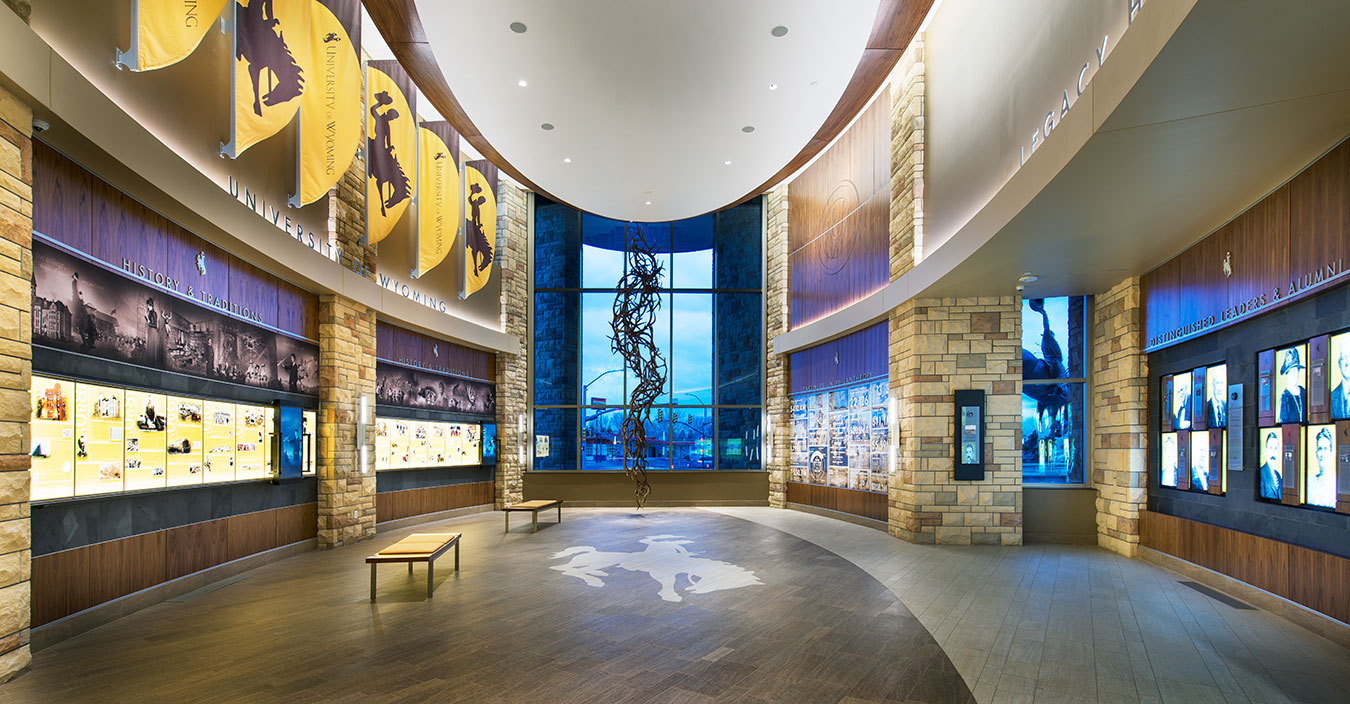
The University of Wyoming Foundation used multiple storytelling techniques to communicate a transformational impact to prospective donors, facilitating their ability to secure gifts at the highest level that would make the Rochelle Gateway Center a reality. The donors were able to see sketches of the building with renderings of their names recognized in proposed locations. They also heard stories that resonated with their personal experiences as alumni, residents of the state, or professionals. Moreover, university leaders explained how the Rochelle Gateway Center would be a remarkable way to make a difference for generations of students and alumni.
What the foundation’s prospective donors processed in a matter of moments was the result of a consistent message and careful planning and collaboration among cross-functional teams, including university administrators, the architect, contractors, and development and marketing professionals, months before the initial ask. An integrated project team enhanced philanthropy and stewardship by using storytelling techniques and defining emotional touchpoints in ways that positioned the donors within the narrative of the university’s mission and strategic plan.
The key to this approach for the university—and other institutions—was to embrace storytelling from the earliest planning stages. This not only resulted in a successful fundraising campaign but also fostered donor relationships with purposeful engagement and thoughtful recognition.
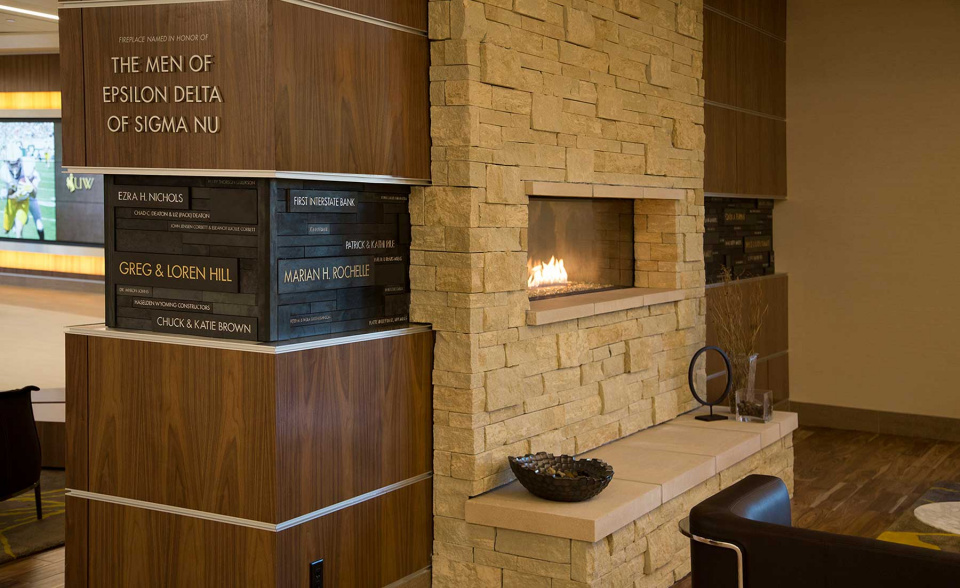
Storytelling as Persuasion
There are several ways to define storytelling. There is a strict definition of storytelling in a literary sense, one that includes plot, characters, setting, and scenes. Storytelling is a familiar strategy in business, branding, and marketing as well.
Researchers and authors repeatedly find that audiences are more likely to remember something they learned in a story compared to when they are presented with facts and data. A story arc, such as the hero’s journey, is ultimately satisfying when the protagonist successfully faces a disruption to their status quo and changes themselves or their world as a result. The emotional highs and lows of a story also help a message resonate on a deeper level. Because storytelling appeals to emotions, it demands attention.
A basic tenet of brand storytelling is to position the customer as a protagonist. In the case of fundraising, the philanthropist is the hero of the story, helping a community or an organization overcome an obstacle. In addition to supporting worthy causes, philanthropists often will have personal motivations for their generosity, such as giving back or leaving a legacy.
When a donor tells the story of their gift to the university, they are unlikely to be proud of naming a conference room or an entry foyer. Rather, they may tell their friends and families about the ground-breaking research or opportunities for students occurring in facilities built with their contributions.
As part of the fundraising for the Rochelle Gateway Center, the University of Wyoming Foundation tapped into philanthropists’ innate desires to be generous, to make a difference, and to leave a legacy. It used a storytelling technique to overcome a challenge or reach a goal. In so many words, the foundation told individual donors: “We can’t do this without you.”
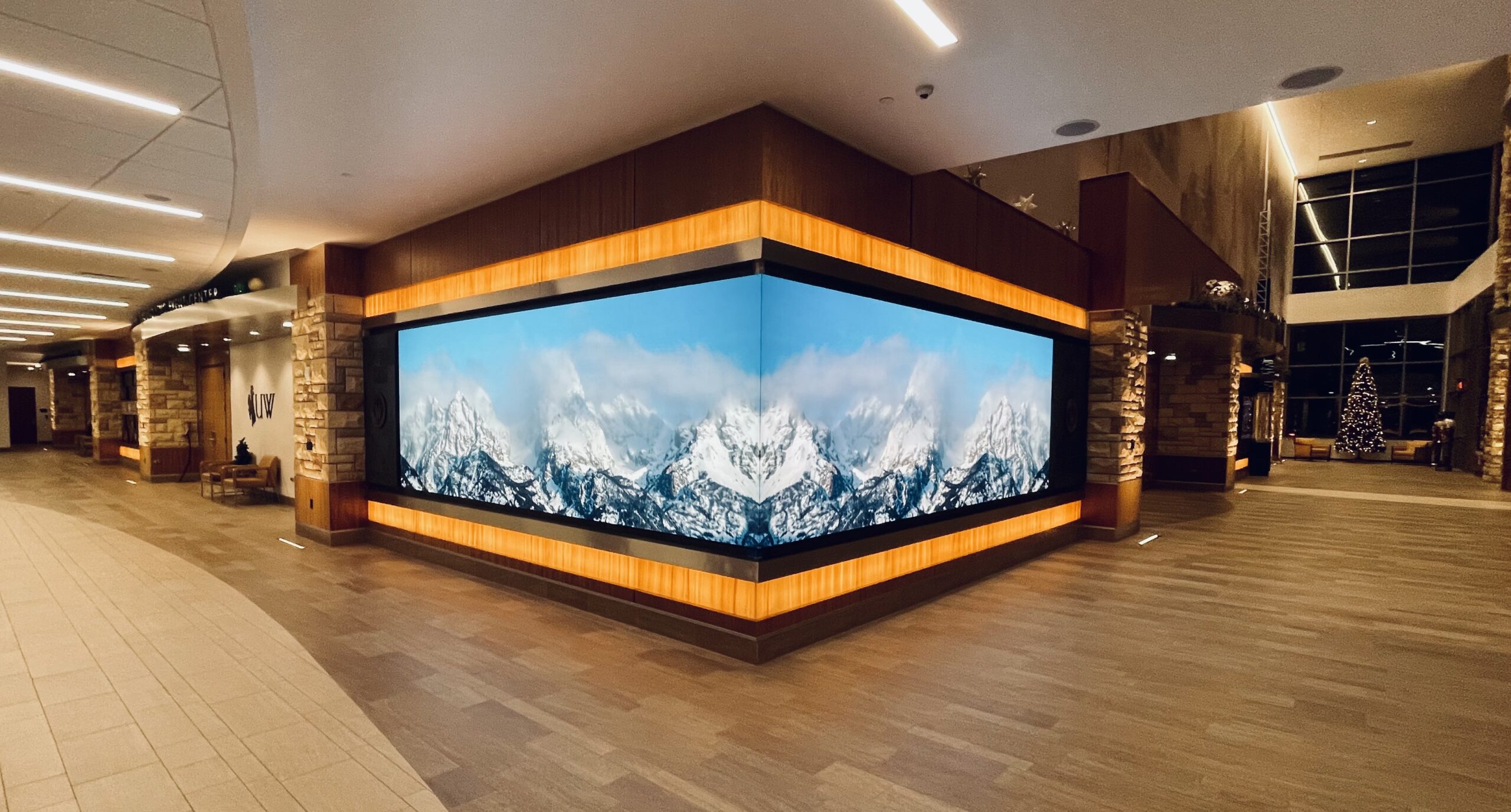
Integrating Teams from the Start
Team integration began at the start of the project. Leadership from the foundation was engaged as a member of the OAC (Owner, Architect, and Contractor) team for the proposed facility in the visioning process because it was to be partially or entirely funded by donors. Most often construction projects and related fundraising priorities originate with the university’s senior administration, which is responsible for the academic mission of the organization. Moreover, new buildings or renovations serve the goals outlined in a university’s long-range development plan or strategic plan.
Through meetings with university leadership, architecture firms, and construction managers, the foundation’s leadership selected and shaped specific messages for donors that highlighted how the building would serve faculty and students and advance the institution. Even if foundation personnel attended meetings with little information relevant to fundraising, they learned through collaboration how the project would fulfill the ultimate purpose of the building.
Meanwhile, the University of Wyoming Foundation personnel considered how the features of the building or the mission of the project would appeal to specific donors. At that stage, staff members from marketing and communications were also involved, and they began to create content and develop media and outreach strategies.
In other words, a comprehensive understanding of the project provided foundation personnel with the information they needed to craft relevant and personal stories to share with both donor audiences and the public.
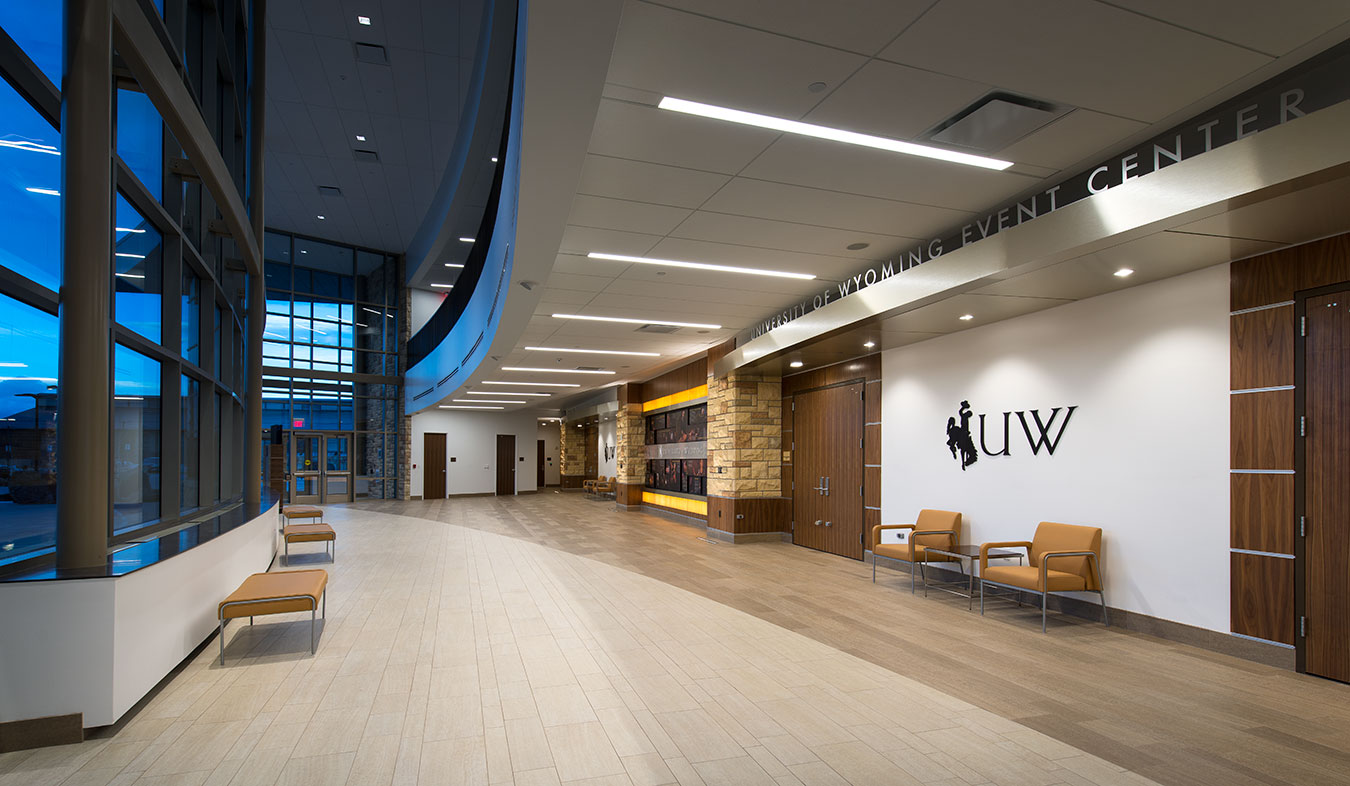
Listening to Understand
Listening to the stories of donors allowed the University of Wyoming Foundation to assemble a Venn diagram of the passions of the donors, the priorities of the institution, and in the case of public land-grant universities like UW the priorities of the state.
Once the foundation staff knew what was at the center of that Venn diagram, they began having conversations on a donor-by-donor basis even before the building had been completed.
Another institution took a story-oriented approach to fundraising for a critical capital project. When the College of Business at the University of Nebraska-Lincoln (Nebraska) began plans to build Hawks Hall, then-dean and executive vice chancellor Donde Plowman had two problems: a fundraising gap and uncertainty about what the facility meant beyond brick and mortar.
Nebraska hired an outside consulting and creative firm, Advent, to clarify the story of the College of Business. Advent interviewed the college’s leaders, alumni, and potential donors on camera and asked them to share their stories about their experiences with the university and the department. They asked how the program shaped their lives and careers. They asked about the students, faculty, and colleagues from the college that inspired them.
The filmed interviews achieved multiple objectives. Plowman had hoped involving prospective donors in the storytelling process would encourage them to contribute; nearly all of them did. The video also was edited into a montage the foundation office would use in additional fundraising outreach. Donors became more excited to contribute when they saw and heard emotional stories from their peers.
In fundraising meetings, Nebraska’s development team now had a pair of storytelling tools at their disposal: the visual renderings from the architect and first-hand stories from alumni. Instead of presenting to donors the square footage per student or the number of classrooms, development officers cast a vision of how the new facility would grow the Nebraska way of doing business, including core values of work ethic, competitiveness, and modest confidence.
“We began thinking about the building project as something more than a building,” said Plowman, who is now the chancellor at the University of Tennessee, Knoxville. “If it’s only about a building, it will only be about limestone and wood and marble. If it’s about something bigger than a building, it’s about who is inside it, what is inside it, what is the mission.”
The stories of individuals at the Nebraska College of Business also clarified the story of the college and redirected design and creative choices within the facility itself. The college’s academic leadership and advancement personnel collaborated with the architect and Advent to determine the placement of donor stories within the completed space.
Beyond room naming and a comprehensive donor recognition display, the foundation office, Advent, the architects, and the College of Business leadership determined how to use the environment to weave storytelling throughout the facility. Because the team collaborated at an early enough stage, they were able to accommodate for the exhibits’ needed space, electrical power, and network connectivity.
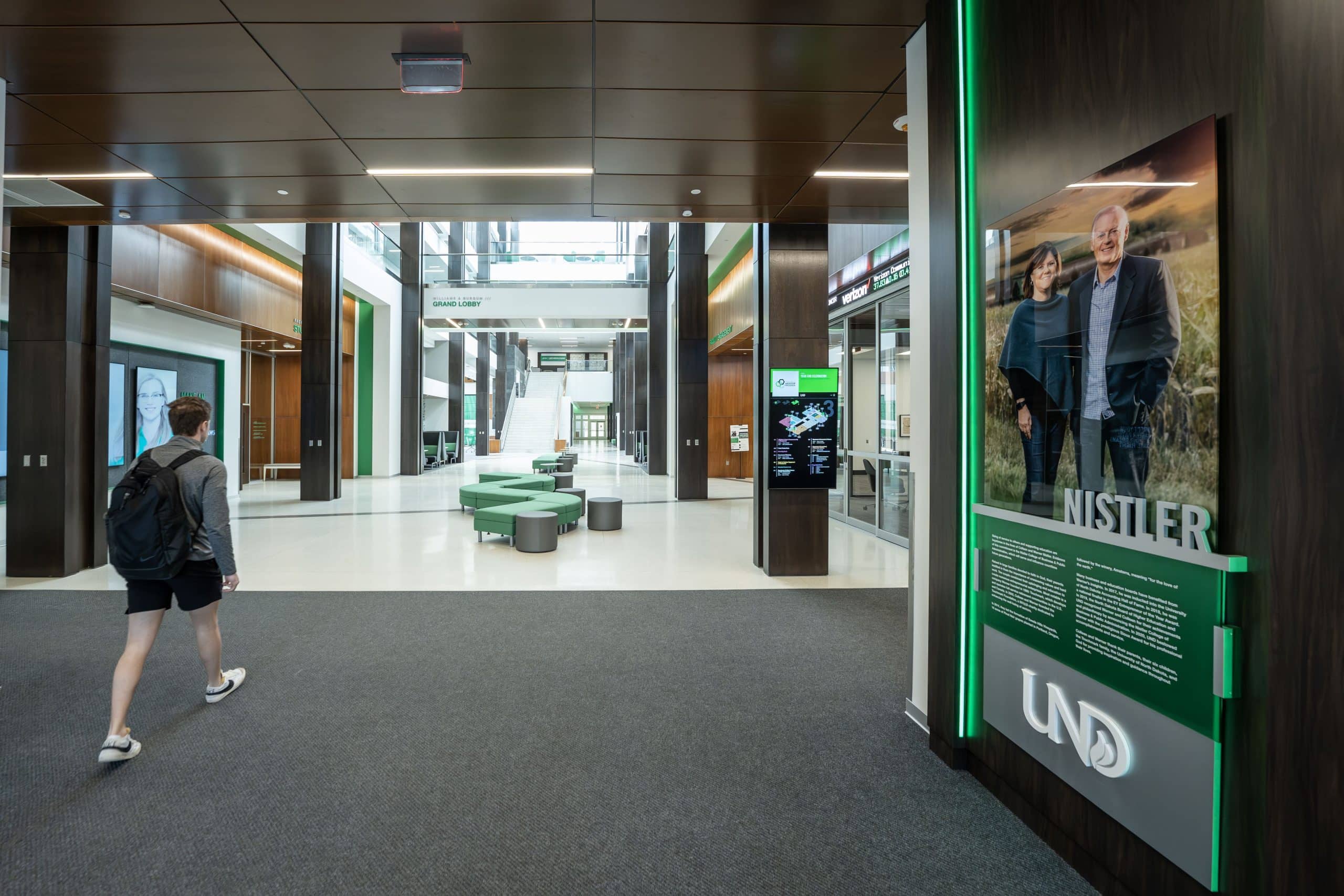
Mapping the Stories
A similar result occurred as part of a cross-functional process at the University of North Dakota (UND) Nistler College of Business and Public Administration (Nistler).
Like the process at Nebraska, multiple UND stakeholders, from students to the dean to alumni to donors, participated in an in-depth discovery process, this time virtually. The collective stories of the stakeholders converged on five story themes: premier, pathway, priorities, passion, and purpose.
Each of those themes reflected the lived experiences of the interview subjects, and each of them reflected the strategic direction established by university and department leaders. The new facility was constructed to help UND achieve those strategic goals.
The architect, academic leadership, foundation staff, and the creative team from Advent then collaborated to map the story themes into relevant areas of the facility. For example, the pathway story theme focused on career opportunities and the values that graduates would have learned at Nistler and bring into the world of business.
Through cross-departmental brainstorming, the team devised a QR code-activated interactive experience for students to explore degree offerings and student testimonials. The collaboration ensured the story would be told at an appropriate location near career services and with the necessary network access and electrical power to support the exhibit.
The teams continued to map the story themes into the facility. The expertise of the architect, development team, and dean was considered, including contributing stories based on traffic flow for students, traffic flow for visitors, and donor recognition objectives. University marketing and communications staff provided insight into available media for placeholder purposes and then provided final images, text, and digital assets during the formal content development phase.
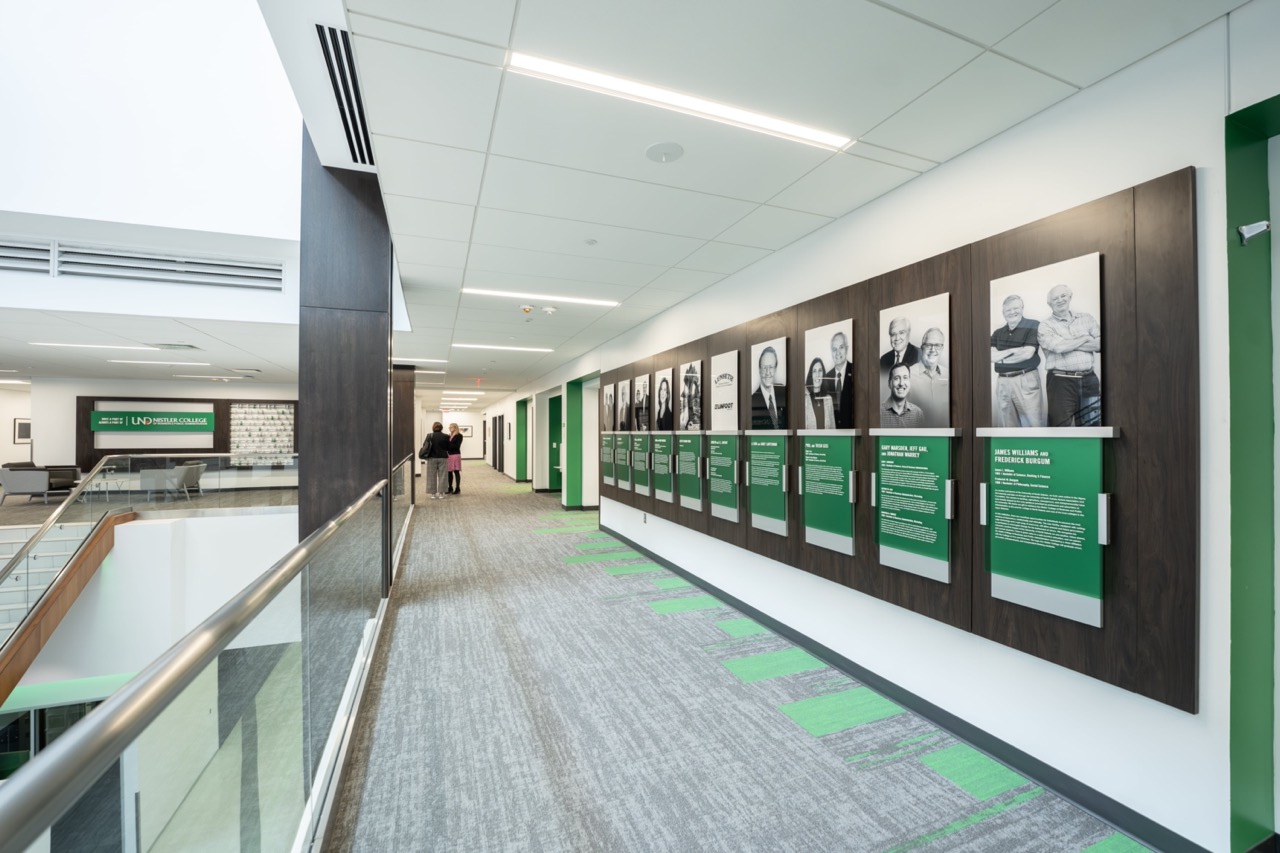
Telling the Story Visually
At Nebraska, the technique of storytelling and a conceptual rendering came together to secure a key gift. Through the listening process, Nebraska and Advent learned that roughly a quarter of student-athletes on campus were business majors. Stories about student-athletes applying their business studies became a priority exhibit. The design team and the College of Business stakeholders determined the café would be an appropriate location for the display.
The foundation was then able to show a rough sketch of the display to a donor, a successful graduate of the business school who was also a former student-athlete. The sketch of the proposed display moved the potential donor to make a sizable gift to the project.
The former student-athlete was one of 2,500 individuals, groups, or charitable foundations that gave to the $84-million project, funded entirely by private donations.
As Nebraska learned, visuals can make a persuasive case for donors. The team at UW used visuals strategically as well. Conversations with donors about a capital project were framed in an expansive and visionary way, sometimes involving both the foundation staff and academic leadership. They told stories less about the specific features and more about what the facility would enable the university to accomplish.
The visuals reflected impressions rather than photorealistic renderings. The foundation team took great care to avoid promising materials or finishes that may need to be scaled down due to inflation or other budgetary concerns. Instead, they worked with the architect or outside consultants to produce sketches. In conjunction with a video or prepared talking points, the presenters led the donor to complete the story themselves.
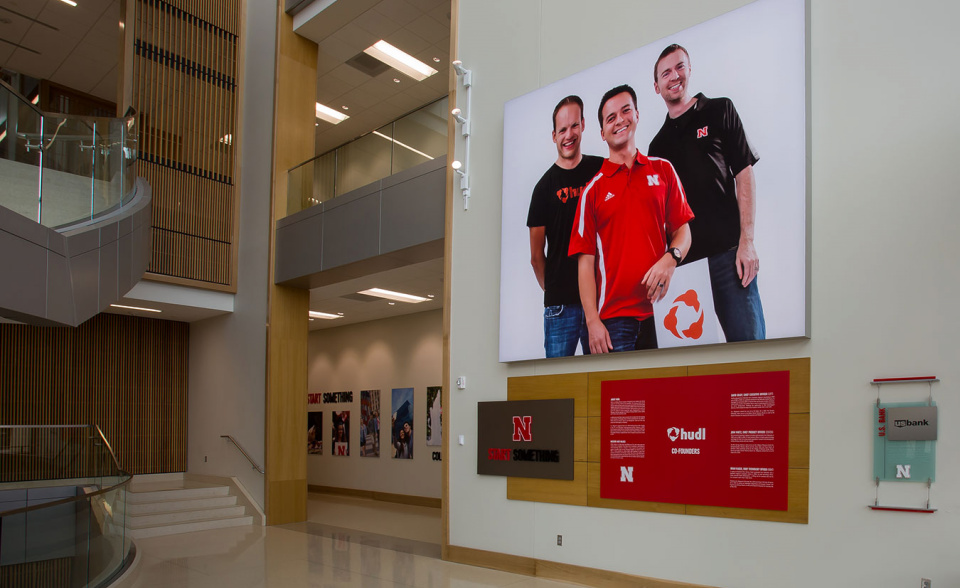
Planning for Donor Stories
As donor engagement personnel attended early planning meetings, they began to consider donor storytelling opportunities. Collaboration at an early stage ensured donor recognition was appropriately tiered based on the amount given, distributed by location in the building, and integrated seamlessly into the facility.
At UW, the foundation’s leadership applied what they learned during the planning stages to establish a recognition system. They identified centralized or high-traffic areas that would be rich with naming opportunities, and they learned about spaces that might host high-value guests and thus demand a higher recognition level. In some cases, the foundation had insight into how particular donors would like to be recognized, or how a donor might request a physical representation to honor a spouse or family member in recognition of their gift.
UND’s Nistler College of Business recognized this approach as well. UND had an enviable problem: many donors to acknowledge in addition to existing donors who needed to be recognized as the Shareholders Society. UND’s architectural partner and foundation personnel along with Advent collaborated early in the process to produce an impact study for donor recognition.
They worked together to create a donor recognition program that fit tiers of donors, based on the available spaces to sell and an appropriate giving level per space. Foundation officers, then, were equipped with a distribution of donors to target at each giving tier. Because the foundation, design team, and architects collaborated during the early schematic and design phases, the recognition elements complemented the aesthetic, mood, and materials of the architecture.
As a result, the UND alumni association and foundation had an accurate visual framework to present to donors, which showed how different giving levels would be recognized in the space. Lower-level donors would be recognized through a comprehensive list or classroom naming. Higher-tier donors would receive a photo and storytelling panel in a high-traffic corridor. The group of longtime donors, the Shareholders Society, would be named on an exhibit—in this case, a nearly six-foot-tall abacus with their names applied to the beads, weighted so that even if visitors turned or moved them, they would return to a position showing the donor’s name.
In addition, the naming donor, the Nistler family, received recognition on the building’s exterior and in the entryway with a high level of material finish.
Because UND took an approach mindful of their donors’ stories early in the process, they were able to recognize the gifts in ways that added to the story of the institution and contributed to, rather than detracted from, the overall human experience of the building.

Extending the Story
Through any capital project, all teams are focused on one endpoint: the ribbon-cutting. For UW, the opening of the building was not the end of the storytelling phase. Foundation personnel will continue to communicate to donors how the institution is meeting its strategic goals with their help. They will ensure donors hear that what they’ve supported has made a difference.
Because of this recognition, many donors to the Marian H. Rochelle Gateway Center also gave to subsequent projects, like the Mick and Susie McMurry High Altitude Performance Center.
“People give to dreams,” says Plowman, the former dean at Nebraska and now the chancellor at Tennessee. “They don’t really give for roofs and walls and floors. Don’t be afraid to touch people’s hearts. People don’t let go of their treasures to help you with your dream unless you’ve somehow moved them emotionally.”